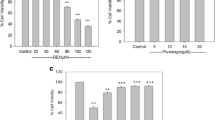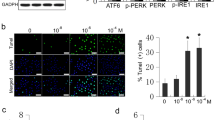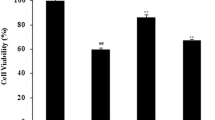Abstract
Apoptosis of osteoblasts triggered by high-dose glucocorticoids (GCs) has been identified as a major cause of osteoporosis. However, the molecular mechanisms underlying GC-induced osteoporosis remain elusive. This study was conducted to make clear the mechanism of GC-induced osteoblast apoptosis and to examine whether reduction of ER stress by 4-PBA inhibited osteoblast apoptosis. After treatment with dexamethasone (Dex) or hydrocortisone, cell viability was assessed using an MTT assay. Flow cytometry was performed to assess the apoptosis of MC3T3-E1 cells. The expression levels of ER stress-related proteins (CHOP, GRP78, eIF2α, and phospho-eIF2α) and apoptosis-related proteins (cleaved Caspase-3, Bcl-2, and Bax) in MC3T3-E1 cells were measured by Western blot analysis. We found that both Dex and hydrocortisone reduced cell proliferation and promoted apoptosis in MC3T3-E1 cells. In addition, the protein expression levels of cleaved Caspase-3 and Bax increased and the protein expression level of Bcl-2 decreased in MC3T3-E1 cells exposed to Dex. In addition, the Dex exposure also resulted in a release of cytochrome c (Cyt C) from mitochondria. The cellular ATP content was decreased following prolonged treatment with Dex. 4-PBA attenuated ER stress and mitochondrial dysfunction induced by Dex in MC3T3-E1 cells. Dex-mediated apoptosis of MC3T3-E1 cells is aggravated by ER stress. Moreover, Dex-induced apoptosis in MC3T3-E1 cells was inhibited by 4-PBA, suggesting that ER stress involved in Dex-induced apoptosis. In conclusion, inhibition of ER stress by 4-PBA could reduce GC-induced apoptosis in MC3T3-E1 cells.




Similar content being viewed by others
References
Musumeci G, Loreto C, Leonardi R, Castorina S, Giunta S, Carnazza ML, Trovato FM, Pichler K, Weinberg AM (2013) The effects of physical activity on apoptosis and lubricin expression in articular cartilage in rats with glucocorticoid-induced osteoporosis. J Bone Miner Metab 31:274–284
Wright NC, Looker AC, Saag KG, Curtis JR, Delzell ES, Randall S, Dawson-Hughes B (2014) The recent prevalence of osteoporosis and low bone mass in the United States based on bone mineral density at the femoral neck or lumbar spine. J Bone Miner Res 29:2520–2526
Yun S-I, Yoon H-Y, Jeong S-Y, Chung Y-S (2009) Glucocorticoid induces apoptosis of osteoblast cells through the activation of glycogen synthase kinase 3β. J Bone Miner Metab 27:140–148
Conradie M, de Wet H, Kotze D, Burrin J, Hough F, Hulley P (2007) Vanadate prevents glucocorticoid-induced apoptosis of osteoblasts in vitro and osteocytes in vivo. J Endocrinol 195:229–240
Zhang K, Kaufman RJ (2008) From endoplasmic-reticulum stress to the inflammatory response. Nature (Lond) 454:455–462
Gorman AM, Healy SJ, Jäger R, Samali A (2012) Stress management at the ER: regulators of ER stress-induced apoptosis. Pharmacol Ther 134:306–316
Menu P, Mayor A, Zhou R, Tardivel A, Ichijo H, Mori K, Tschopp J (2012) ER stress activates the NLRP3 inflammasome via an UPR-independent pathway. Cell Death Dis 3:e261
Li N, Zoubeidi A, Beraldi E, Gleave ME (2013) GRP78 regulates clusterin stability, retrotranslocation and mitochondrial localization under ER stress in prostate cancer. Oncogene 32:1933–1942
Gardner BM, Walter P (2011) Unfolded proteins are Ire1-activating ligands that directly induce the unfolded protein response. Science 333:1891–1894
Bertolotti A, Zhang Y, Hendershot LM, Harding HP, Ron D (2000) Dynamic interaction of BiP and ER stress transducers in the unfolded-protein response. Nat Cell Biol 2:326–332
Jiang H-Y, Wek RC (2005) Phosphorylation of the α-subunit of the eukaryotic initiation factor-2 (eIF2α) reduces protein synthesis and enhances apoptosis in response to proteasome inhibition. J Biol Chem 280:14189–14202
Boyce M, Bryant KF, Jousse C, Long K, Harding HP, Scheuner D, Kaufman RJ, Ma D, Coen DM, Ron D (2005) A selective inhibitor of eIF2α dephosphorylation protects cells from ER stress. Science 307:935–939
Shen M, Wang L, Yang G, Gao L, Wang B, Guo X, Zeng C, Xu Y, Shen L, Cheng K (2014) Baicalin protects the cardiomyocytes from ER stress-induced apoptosis: inhibition of CHOP through induction of endothelial nitric oxide synthase. PLoS One 9:e88389
Yam GH-F, Gaplovska-Kysela K, Zuber C, Roth J (2007) Sodium 4-phenylbutyrate acts as a chemical chaperone on misfolded myocilin to rescue cells from endoplasmic reticulum stress and apoptosis. Invest Ophthalmol Vis Sci 48:1683–1690
Basseri S, Lhoták Š, Sharma AM, Austin RC (2009) The chemical chaperone 4-phenylbutyrate inhibits adipogenesis by modulating the unfolded protein response. J Lipid Res 50:2486–2501
Liu W, Zhu X, Wang Q, Wang L (2013) Hyperglycemia induces endoplasmic reticulum stress-dependent CHOP expression in osteoblasts. Exp Ther Med 5:1289–1292
Liu L, Zhang Y, Gu H, Zhang K, Ma L (2015) Fluorosis induces endoplasmic reticulum stress and apoptosis in osteoblasts in vivo. Biol Trace Elem Res 164:64–71
Park S-J, Kim K-J, Kim W-U, Oh I-H, Cho C-S (2012) Involvement of endoplasmic reticulum stress in homocysteine-induced apoptosis of osteoblastic cells. J Bone Miner Metab 30:474–484
Kammoun HL, Chabanon H, Hainault I, Luquet S, Magnan C, Koike T, Ferré P, Foufelle F (2009) GRP78 expression inhibits insulin and ER stress-induced SREBP-1c activation and reduces hepatic steatosis in mice. J Clin Invest 119:1201
Nishitoh H (2012) CHOP is a multifunctional transcription factor in the ER stress response. J Biochem (Tokyo) 151:217–219
Özcan U, Yilmaz E, Özcan L, Furuhashi M, Vaillancourt E, Smith RO, Görgün CZ, Hotamisligil GS (2006) Chemical chaperones reduce ER stress and restore glucose homeostasis in a mouse model of type 2 diabetes. Science 313:1137–1140
Hetz C (2012) The unfolded protein response: controlling cell fate decisions under ER stress and beyond. Nat Rev Mol Cell Biol 13:89–102
Kamiya T, Obara A, Hara H, Inagaki N, Adachi T (2011) ER stress inducer, thapsigargin, decreases extracellular-superoxide dismutase through MEK/ERK signalling cascades in COS7 cells. Free Radic Res 45:692–698
Rauch A, Seitz S, Baschant U, Schilling AF, Illing A, Stride B, Kirilov M, Takacz A, Schmidt-Ullrich R, Ostermay S (2010) Glucocorticoids suppress bone formation by attenuating osteoblast differentiation via the monomeric glucocorticoid receptor. Cell Metab 11:517–531
Brennan-Speranza TC, Henneicke H, Gasparini SJ, Blankenstein KI, Heinevetter U, Cogger VC, Svistounov D, Zhang Y, Cooney GJ, Buttgereit F (2012) Osteoblasts mediate the adverse effects of glucocorticoids on fuel metabolism. J Clin Invest 122:4172
Kim H-J, Zhao H, Kitaura H, Bhattacharyya S, Brewer JA, Muglia LJ, Ross FP, Teitelbaum SL (2006) Glucocorticoids suppress bone formation via the osteoclast. J Clin Invest 116:2152
Humphrey E, Williams JH, Davie MW, Marshall MJ (2006) Effects of dissociated glucocorticoids on OPG and RANKL in osteoblastic cells. Bone (NY) 38:652–661
Chen F, Zhang L, OuYang Y, Guan H, Liu Q, Ni B (2014) Glucocorticoid induced osteoblast apoptosis by increasing E4BP4 expression via up-regulation of Bim. Calcif Tissue Int 94:640–647
Walsh S, Jordan G, Jefferiss C, Stewart K, Beresford J (2001) High concentrations of dexamethasone suppress the proliferation but not the differentiation or further maturation of human osteoblast precursors in vitro: relevance to glucocorticoid-induced osteoporosis. Rheumatology 40:74–83
Szegezdi E, Logue SE, Gorman AM, Samali A (2006) Mediators of endoplasmic reticulum stress-induced apoptosis. EMBO Rep 7:880–885
Li J, Ni M, Lee B, Barron E, Hinton D, Lee A (2008) The unfolded protein response regulator GRP78/BiP is required for endoplasmic reticulum integrity and stress-induced autophagy in mammalian cells. Cell Death Differ 15:1460–1471
Pincus D, Chevalier MW, Aragón T, Van Anken E, Vidal SE, El-Samad H, Walter P (2010) BiP binding to the ER-stress sensor Ire1 tunes the homeostatic behavior of the unfolded protein response. PLoS Biol 8:e1000415
Sano R, Reed JC (2013) ER stress-induced cell death mechanisms. Biochim Biophys Acta 1833:3460–3470
Zhang X, Yuan Y, Jiang L, Zhang J, Gao J, Shen Z, Zheng Y, Deng T, Yan H, Li W (2014) Endoplasmic reticulum stress induced by tunicamycin and thapsigargin protects against transient ischemic brain injury: involvement of PARK2-dependent mitophagy. Autophagy 10:1801–1813
Goldstein JC, Waterhouse NJ, Juin P, Evan GI, Green D (2000) The coordinate release of cytochrome c during apoptosis is rapid, complete and kinetically invariant. Nat Cell Biol 2:156–162
Sato AY, Tu X, Mcandrews KA, Plotkin LI, Bellido T (2015) Prevention of glucocorticoid induced-apoptosis of osteoblasts and osteocytes by protecting against endoplasmic reticulum (ER) stress in vitro, and in vivo, in female mice. Bone (NY) 73:60–68
Acknowledgments
This work was funded by the Natural Science Foundation of Shaanxi Province (Grant No. 2014JM4193).
Author information
Authors and Affiliations
Corresponding author
Ethics declarations
Conflict of interest
The authors declare that there are no conflicts of interest.
Additional information
J. Yang and Q. Wu contributed equally to this work.
About this article
Cite this article
Yang, J., Wu, Q., Lv, J. et al. 4-Phenyl butyric acid prevents glucocorticoid-induced osteoblast apoptosis by attenuating endoplasmic reticulum stress. J Bone Miner Metab 35, 366–374 (2017). https://doi.org/10.1007/s00774-016-0778-3
Received:
Accepted:
Published:
Issue Date:
DOI: https://doi.org/10.1007/s00774-016-0778-3




